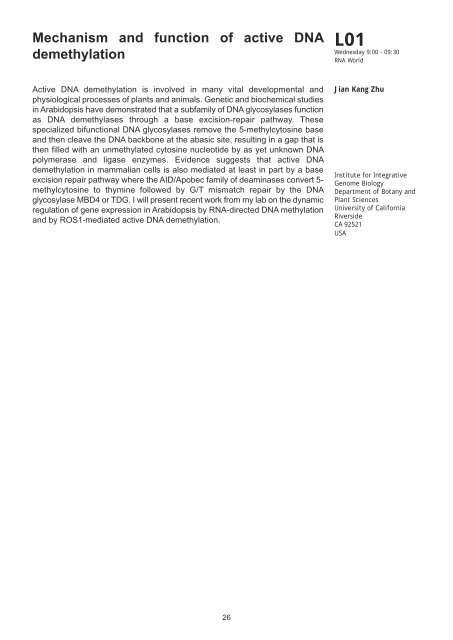Edinburgh, Scotland, United Kingdom - TAIR
Edinburgh, Scotland, United Kingdom - TAIR
Edinburgh, Scotland, United Kingdom - TAIR
Create successful ePaper yourself
Turn your PDF publications into a flip-book with our unique Google optimized e-Paper software.
Mechanism and function of active DNA<br />
demethylation<br />
Active DNA demethylation is involved in many vital developmental and<br />
physiological processes of plants and animals. Genetic and biochemical studies<br />
in Arabidopsis have demonstrated that a subfamily of DNA glycosylases function<br />
as DNA demethylases through a base excision-repair pathway. These<br />
specialized bifunctional DNA glycosylases remove the 5-methylcytosine base<br />
and then cleave the DNA backbone at the abasic site, resulting in a gap that is<br />
then filled with an unmethylated cytosine nucleotide by as yet unknown DNA<br />
polymerase and ligase enzymes. Evidence suggests that active DNA<br />
demethylation in mammalian cells is also mediated at least in part by a base<br />
excision repair pathway where the AID/Apobec family of deaminases convert 5methylcytosine<br />
to thymine followed by G/T mismatch repair by the DNA<br />
glycosylase MBD4 or TDG. I will present recent work from my lab on the dynamic<br />
regulation of gene expression in Arabidopsis by RNA-directed DNA methylation<br />
and by ROS1-mediated active DNA demethylation.<br />
26<br />
L01<br />
Wednesday 9:00 - 09:30<br />
RNA World<br />
Jian Kang Zhu<br />
Institute for Integrative<br />
Genome Biology<br />
Department of Botany and<br />
Plant Sciences<br />
University of California<br />
Riverside<br />
CA 92521<br />
USA




